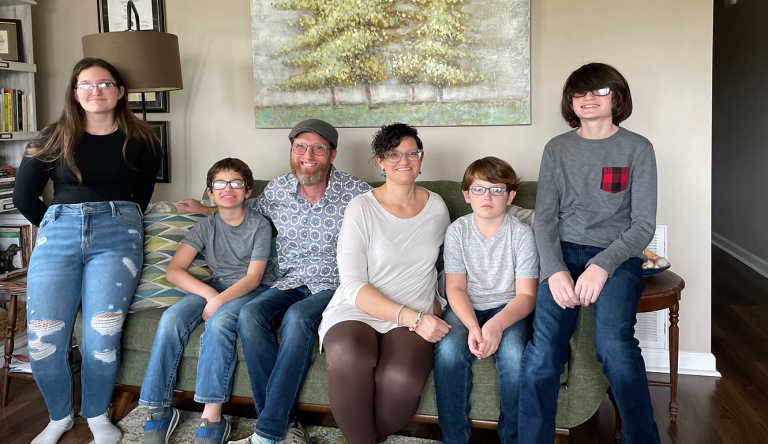Eighty Surgeries Later, Smart is Thriving
By Chris Rogers | December 3, 2022
To many in Ocean Springs, Mississippi, Jeffrey Smart is just another neighbor: a father of four, an employee at the local Wal-Mart, a homeowner, a regular churchgoer.
To the Dandy-Walker community, he is a beacon of hope, a symbol of perseverance. He’s had more than 80 brain surgeries and shunt revisions, including more than 60 before he turned 18 years old. But now, at 40 years old, he lives what many would call a normal American life.
Smart was born in Biloxi, Mississippi, in 1982, the son of an air traffic controller and a stay-at-home mom later turned schoolteacher. A few weeks after birth, he was diagnosed with Dandy-Walker. He had a large cyst on his fourth ventricle which caused hydrocephalus. Doctors put in a shunt, relieving the pressure and keeping him symptom-free for the next four years.
“I was your regular kid, I did everything else that kids do,” he said. “Then, when I was four years old, I had to have a shunt revision. From age four to eight years old, I had 23 more of them.”
It became an all-too-familiar cycle: Smart would have a headache that just wouldn’t go away. He’d go to the hospital and the doctors would do a scan and find a clogged shunt. They’d do a revision to fix it. Then his head would start hurting again and he’d be back to square one.
At age eight, the shunt finally held. He didn’t need any revisions or operations for the next six years. He thrived in school – earning Honor Roll marks and straight A’s, winning school spelling bees and even coming second in the regional contest one year.
Through elementary and middle school, Smart attended the small private school where his mom taught. He thrived in the small classes and tight-knit community. But the K-8 school didn’t offer a high school curriculum, so off to public school he went for ninth grade.

It was a bit of a culture shock, he said. After a couple months, he started to find his groove and feel more comfortable. But then, on December 2, he went in for his first shunt revision in six years. That revision failed, and he went in for another one a week later. A month later, the shunt got infected, and he spent a month in the ICU.
He missed out on seeing his friends and his church youth group in what he called a formative time in his life, but it wasn’t all bad. He laughs remembering how nurses brought snacks and a TV up to his room for a mini Superbowl watch party. The Green Bay Packers – his favorite team – won.
But after his hospital stay and another failed shunt, his doctor didn’t know what to do anymore.
“My head kept hurting constantly, even after the operations. And she just gave up,” Smart said.
But he didn’t want to give up. Neither did his parents, who drove him four and a half hours to Birmingham, Alabama, to get a new opinion.
The doctor in Birmingham took one look and found multiple shunts that weren’t connected to anything, meaning they weren’t draining or relieving the pressure in his head. They sent him into surgery to revise them, giving him “immediate relief.”
Of course, this wasn’t the end of the process for Smart. All in all, he had nearly 40 surgeries between age 14 and 19. His hospital visits forced him to miss too much time in school, and he dropped out and got his GED.
While he sometimes felt isolated, he had unconditional love and support from his parents to keep him going.
“My parents always encouraged me,” he said. “They always told me you’re going to do this; you’re going to have a wife, you’re going to have a family. That’s what pushed me. That’s what kept me going.”
Fast forward to 2004, and Smart, then 22, connected with a girl named Christine in an online Christian chatroom. They quickly began talking every day, often for several hours. After a few months of talking, Smart flew to Long Island to meet Christine in person. He felt an instant spark when he saw her for the first time.
They married in 2007 and took a honeymoon cruise to the Caribbean – Smart’s first time out of the country. Then, they returned to Biloxi and got an apartment near the mall where they both worked.
Their daughter, Morgan, was born a year later. Then came Noah, their first son, two years after that. When Christine became pregnant again, they needed more space than their Biloxi apartment had to offer. After moving up to New York for a short while to be with Christine’s parents, they found a four-bedroom house for sale in Ocean Springs, just outside of Biloxi. It was in a great school district, close to a new Wal-Mart where Smart could work, and most importantly, in their price range.
Now, their family of six is complete, with Morgan, Noah, and two younger boys, Hyett and Travis, all living in the home they own.
Smart still has seizures every few months, but his medication makes them much more manageable than they used to be. With everything that he has overcome, now he wants to be an inspiration for the other children and families out there affected by Dandy-Walker, hydrocephalus, and epilepsy.
“I’ve got a family. I’ve got a house. I’ve got everything a guy can want. Especially for someone who has had 80 surgeries.”



